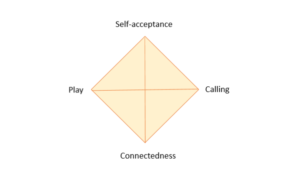(Different to my other blog posts, this is a long essay on my coaching model)
At a very fundamental level, I believe the purpose of coaching is to support the individual to live in a manner that embraces their wellbeing, is fully engaged with the world and in harmony with all that is. Through research, observations and my personal experiences I have developed a model for life that I believe allows one to live in such a way. This model emerged out of an investigation of the overarching question of ‘how we must live’ and it now lies at the heart of my coaching practice, shaping both my coach presence and the nature of my interventions.
My life model / coaching model envisages the simultaneous embodiment of four key attributes: self-acceptance, connectedness, play and calling.
Figure 1: Coaching Model

The access to these attributes lies in the understanding of certain core principles. Access can be quick and I believe it begins with seeing into our own nature and thereby the nature of all things. The Chan Buddhist monk Huìnéng (638-713 AD) referred to this is as “swift seeing” arising from “self-awakening to self-nature and sudden practice with sudden awakening” (Huìnéng, 1967, pp.164-165). This idea has important implications for coaching, as I believe powerful personal change can be effected quickly. We will now explore the four attributes of the model and the principles that underlie them.
Attribute I: Self-acceptance
Self-acceptance refers to the individual’s relationship to themselves. Acknowledgement of who we are is essential to our wellbeing and to being able to fully engage in the world. I view self- acceptance as being underpinned by four core principles.
Principle (i): We are susceptible to the illusion of being ‘in control’ in our culture today
Atomistic individuality characterised by an obsession with ambition and competition have become salient features of our world, first emerging in the post-Renaissance age of Enlightenment and coming to bear its full force in the modern and post-modern eras (McGilchrist, 2009). Ian McGilchrist attributes this situation to the ascendency of the left hemisphere of the brain over the right hemisphere. The right hemisphere is seen to be the source of creativity and emotional understanding, while the left hemisphere is viewed as being occupied with rationality and the certainty of knowledge.
McGilchrist believes the essential difference between the two hemispheres is that the right “pays attention to whatever it is that exists apart from ourselves, with which it sees itself in profound relation to…[while]…the left pays attention to the virtual world it has created, which is self-consistent, but self-contained” (McGilchrist, 2009, p.93). Others, such as Owen Flanagan, Professor of Neurobiology and Philosophy, disagree with McGilchrist noting that “hemispheric differences are not well understood” (Flanagan, 2009). Whether or not these differences are physiologically attributable to the two hemispheres, I believe the conceptual differentiation provides a powerful lens through which to understand human behaviour.
Language, for example, is very much the dominion of the left hemisphere and “returns us inevitably to the worn currency of re-presentation, in which the unique qualities of everything that exists are reduced to the same set of terms” (McGilchrist, 2009, p.74). I believe the preponderance of linguistic (and to a lesser degree mathematical) reasoning in our culture can have significant adverse implications on the manner in which we relate to ourselves and the world, by limiting the scope of our perception and intelligence. The educationalist Ken Robinson expresses a similar view by recognising that “intelligence can show itself in ways that have little or nothing to do with numbers and words” (Robinson and Aronica, 2009, p.48).
McGilchrist traces the rise of the left hemisphere to the “hubristic movement which came to be know as the Enlightenment”, which saw the right hemisphere’s wisdom being devalued as “irrational and therefore wrong” (McGilchrist, 2009, p.329). Today, we observe the dominance of linear, reductionist, rational thinking in all walks of life, where this has perpetuated a culture that constantly seeks to be in control. Both our obsession with control and the illusion of it is clearly evident in society’s approach to accidents, illness and death. “The left hemisphere sees itself as the passive victim of whatever it is not conscious of having willed” (McGilchrist, 2009, p.432). Death therefore represents the ultimate challenge to our sense of control and is viewed as something to be feared and delayed, rather than accepted as a natural cadence in the ebb and flow of life.
Society’s attitudes towards death have not always been the same. Death was omnipresent in life and literature both during the renaissance and much before. Ruins uncovered from the ancient Roman city of Pompei (600 BC – 79 AD) show how people embraced death as part of the very fabric of life. A skeleton etched on a Pompei dinner table accompanied by the words carpe diem is a striking example of how death was not seen as something to be feared, but rather something that provided meaning to life. In the words of Brother Rogers, the founder of the Taizé Community, “consenting to our own death allows us to rediscover a flow of life” (Rogers, 2007, p.121).
In summary, I believe that the false fear of losing control over ourselves and our environment is created by a cultural tendency towards atomistic individuality and linear reductionist thought, which is exacerbated by predominantly linguistic reasoning. I believe this tendency is a significant threat to our wellbeing. Augmented by the forces of capitalism, we know that urban life is associated with high rates of depression. The UK Mental Health Foundation estimates that “1 in 4 people will experience some kind of mental health problem during the course of a year” (UK Mental Health Statistics, 2015). I believe our obsession with control hinders us from seeing our true nature. It also deludes us from recognising our interconnectedness to all that is, something that will be discussed in detail under principle (v).
Principle (ii): Embracing vulnerability is fundamental to our wellbeing
This refers to the somewhat paradoxical idea that only by allowing ourselves to be vulnerable can we truly access experiences such as joy, love and creativity—the experiences that make us the most vulnerable, but are at the centre of wholehearted living (Brown, B, 2010). Through data collected from the life stories of over ten thousand men and women, Brené Brown found that “if we want to live and love with our whole hearts, and if we want to engage with the world from a place of worthiness, we have to talk about the things that get in the way – especially shame, fear and vulnerability” (Brown, B, 2010, p.36). This is particularly true in a competitive culture where projecting strength and perfection is ubiquitous.
While Brown’s basic idea of transcending fear by acknowledging and accepting it, is certainly not new and one present in eastern philosophies such as Buddhism, her major contribution is the focus on vulnerability and shame. Brown defines shame as the belief that “we are flawed and therefore unworthy of love and belonging” (Brown, B, 2010, p.39). Shame affects us all and can deeply impact our well-being. I believe embracing vulnerability is vital, as it not only serves as the gateway to facing fear and shame, but also provides the access to those experiences such as love, empathy and joy that are fundamental to our wellbeing.
Principle (iii): Self-forgiveness is required to accept all our emotions
I believe that the nature of human consciousness is such that it involves a natural tendency towards a multitude of emotions, including those such as love and empathy, as well as emotions such as anger and fear. Commenting on “man’s drives”, Jung refers to “expressions of psychic energy” and views them as “various manifestations of energetic processes and thus as forces analogous to heat, light etc.” (Jung, 1960, pp.234-235, Jung, 1928). While Jung was specifically commenting on the unconscious, I believe the phenomenon is more universally true of human nature.
In his work, Phil Best notes that even those emotions such as anger, despair and shame are “not a mistake of nature” but rather “distortions and imbalances” that provide us with “useful feedback to react and restore balance” (Best, 2015, p.3). I agree that it is the manner in which we react to these imbalances that is the key and believe that self-forgiveness is therefore
necessary to allow a deep acceptance of ourselves. I refer to self-forgiveness in a similar sense to the Buddhist idea of maitrī (sanskrit), commonly translated as loving-kindness or unconditional love, but with a specific focus on the self here.
Principle (iv): Cultivating awareness is the gateway to self-acceptance
I believe that cultivating awareness (or mindfulness) provides a sense of mental calm that creates the backdrop for noticing our behaviours, attitudes and tendencies, which in turn provide us with powerful insights into ourselves and our environments. Practicing awareness has been a central tenet of numerous Buddhist and Hindu traditions and is considered to be fundamental to the path to ‘enlightenment’. Commenting on awareness, the Theravada Buddhist monk Ajahn Chah notes that “when the mind is peaceful and established firmly in mindfulness and self- awareness, there will be no doubt concerning the various phenomena which we encounter. The mind will truly be beyond the hindrances” (Chah, 2011, p.310).
Attribute II: Connectedness
Connectedness refers to the manner in which we relate to the world around us. Connectedness is about recognising that we are part of the whole and is underpinned by one very important core principle.
Principle (v): We are not isolated egos in bags of skin
This principle acknowledges that we are not only connected to each other, but to all things that exist more generally. While Jung noted that “the collective unconscious is common to all” (Jung, 1960, p. 160), I believe that our connectedness extends beyond just humanity. In a letter to a father grieving the death of his young son, Albert Einstein observed that “a human being is a part of the whole, called by us “Universe”, a part limited in time and space. He experiences himself, his thoughts and feelings as something separate from the rest – a kind of optical delusion of his consciousness” (Einstein, 2011).
The idea that we are each an isolated ego striving in the world is a view that is deeply embedded in our culture today. This is reflected not just in pervasive individualism, but also in the vernacular of how we describe human existence. For example, we speak of coming “into the world”, rather than coming “out of” it. The former implies that we are somehow separate from nature rather than “an expression of the whole realm of nature, a unique action of the total universe. Even those who know it to be true in theory do not sense or feel it, but continue to be aware of themselves as isolated egos inside bags of skin” (Watts, 1973, p.15). While rational recognition of this is the starting point, I believe that only by embodying it can we access true connectedness.
A lack of connectedness in society today, exacerbated by a cultural desire for control, threatens our wellbeing by creating the basis for fear and anxiety. I believe that embodying connectedness is crucial to our wellbeing as it extends self-acceptance (attribute I) to a deeper level by recognising that the individual is an expression of the universe. This deep acceptance lies at the heart of love, empathy and compassion towards all things.
Attribute III: Play
Play refers to the manner in which we relate to our life journey. Play is about engaging in life with curiosity and interest, rather than achievement-centred earnestness. The need for play is underpinned by the following core principle:
Principle (vi): Our obsession with measurable results is adverse to our wellbeing
The pursuit of “success” in our world has led us to focus on accolades, achievements and measurable results in order to derive gratification. Life today has become about “making progress” and “getting somewhere”. Play refers to the childlike curiosity and zest with which we could engage in life. It is about playing for the sake of play, rather than for any results.
In his work, clinical researcher and psychiatrist Stuart Brown identifies seven properties of play, the first of which is that play is “apparently purposeless” (Brown and Vaughan, 2009). Brown highlights the importance of play when he writes; “Respecting our biologically programmed need for play, can transform work. Play helps us deal with difficulties, provides a sense of expansiveness, promotes mastery of our craft, and is an essential part of the creative process. Most important, true play that comes from our own inner needs and desires is the only path to finding lasting joy and satisfaction in our work. In the long run, work does not work without play” (Brown, and Vaughan, 2009).
I believe that play should be viewed as more than just a tool to facilitate work and that there should be no separation between work and play. Life should be play. Indeed, this idea has significant implications for executive coaching. Commenting on the secret of happiness, Bertrand Russell advocates letting our “interests be as wide as possible” (Russell, 2006, p.109). While not definitive in his language, I believe that Russell was advocating an attitude of play towards life that emanates from taking a general interest in the world.
Play is supported by self-acceptance (attribute I) and connectedness (attribute II) in allowing us to be “citizens of the universe, enjoying freely the spectacle that it offers and the joys that it affords, untroubled by the thought of death because we feel ourselves not really separate from those who will come after” (Russell, 2006, p.175).
Attribute IV: Calling
This attribute recognises our inherent need to devote our energies to a passion (or passions), which we will each have our own unique attraction to. I believe it is probable, though not necessarily inevitable, that even self-accepting, connected and playful individuals could feel a sense of incompleteness without a calling. It is for this reason that calling represents the fourth attribute of my model. Calling is underpinned by one core principle:
Principle (vii): We all need something(s) of interest to occupy ourselves with
While it is conceivable that some of us might find fulfilment by taking a general interest in the world, I postulate that most of us would be attracted to certain pursuits, be it carpentry, beekeeping, coaching or trekking. Ken Robinson coined the term “the Element” to describe “the place where the things you love to do and the things you are good at come together” (Robinson and Aronica, 2009, p.8). Robinson believes the Element manifests itself differently in every person and that we need it “to make the best of ourselves and of each other” (Robinson and Aronica, 2009, p.xiv).
While I agree with Robinson’s general idea that we each need to find our unique passion, I do not believe that one needs to be limited by what one appears to be good at. I believe that with sufficient interest, enormous skill can be developed over time. As the virtuoso pianist Phil Best said in conversation to me, “your skill is only as great as your passion” (Best, 2014). I believe it is more conducive to our wellbeing to follow our true calling, rather than to focus on pursuits that we may have more aptitude for, but are fundamentally less passionate about.
Conclusion
At a very fundamental level, I believe the purpose of coaching is to support the individual to live in a manner that embraces their wellbeing, is fully engaged with the world and in harmony with all that is. I believe my life model offers such a way of living and as such, it lies at the heart of my coaching practice. If I coach from a place of self-acceptance, connectedness, play and calling, to the extent I can muster, I trust that my coach presence and interventions will allow the coachee to explore their goals in an environment that supports their overall wellbeing. I am not offering my life model as the way, but rather suggest that the attributes contained therein should, at the very least, be addressed in holistic approaches to living today. This is because certain cultural tendencies of our time, such as atomistic individualism and reductionist thinking, demand that particular aspects be emphasised. Having a model for life also allows me to better test hypotheses in relation to the coachee’s situation.
In conclusion, what lies at the core of my practice is a holistic approach to living from which emanates a way of being as a coach. While supported with various coaching techniques and diagnostic tools, I believe it is the approach to living itself that requires my primary attention.





Trackbacks/Pingbacks